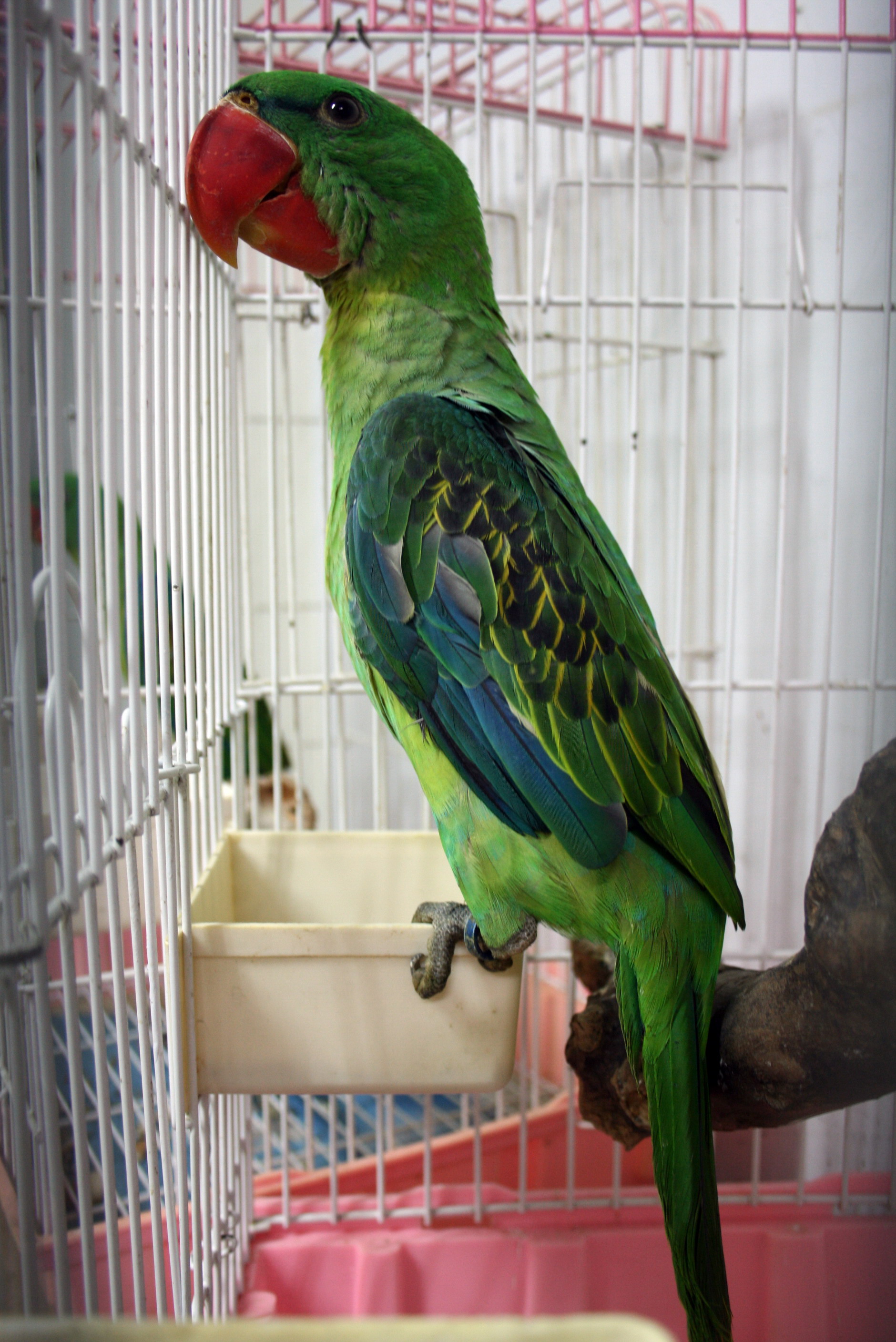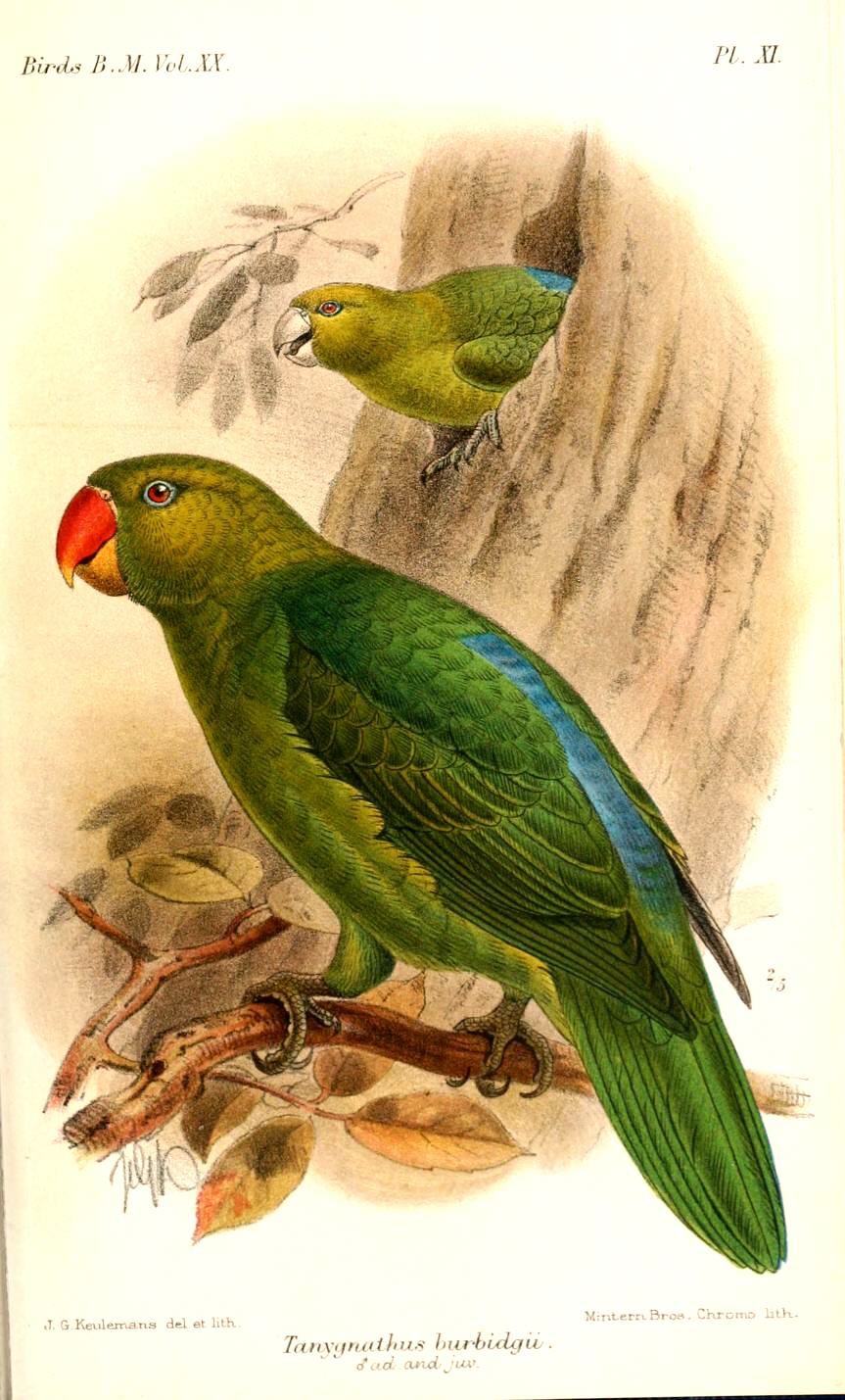|
Tanygnathus
''Tanygnathus'' is a genus of parrots in the Psittaculini tribe, of the superfamily of true parrots, Psittacoidea (true parrots). Its species are native to Southeast Asia and Melanesia. Taxonomy The genus ''Tanygnathus'' was introduced by the German naturalist Johann Georg Wagler, Johann Wagler in 1832. The type species was subsequently designated as the great-billed parrot (''Tanygnathus megalorynchos'') by the English zoologist George Robert Gray in 1840. The name ''Tanygnathus'' combines the Ancient Greek words ''tanuō'' "to stretch out" and ''gnathos'' "jaw". The genus contains five species: Genetic analysis has supported reclassifying all 4 species under ''Psittacula'', making ''Tanygnathus'' a synonym of the former genus. References Tanygnathus, Psittaculini Bird genera Birds of Malesia {{parrot-stub ... [...More Info...] [...Related Items...] OR: [Wikipedia] [Google] [Baidu] |
Tanygnathus Sumatranus -adult Male-8-1c
''Tanygnathus'' is a genus of parrots in the Psittaculini tribe, of the superfamily of Psittacoidea (true parrots). Its species are native to Southeast Asia and Melanesia. Taxonomy The genus ''Tanygnathus'' was introduced by the German naturalist Johann Wagler in 1832. The type species was subsequently designated as the great-billed parrot (''Tanygnathus megalorynchos'') by the English zoologist George Robert Gray in 1840. The name ''Tanygnathus'' combines the Ancient Greek words ''tanuō'' "to stretch out" and ''gnathos'' "jaw". The genus contains five species: Genetic analysis has supported reclassifying all 4 species under ''Psittacula ''Psittacula'', also known as Afro-Asian ring-necked parrots, is a genus of parrots from Africa and Southeast Asia. It is a widespread group with a clear concentration of species in south Asia, but also with representatives in Africa and the isla ...'', making ''Tanygnathus'' a synonym of the former genus. References Psittacul ... [...More Info...] [...Related Items...] OR: [Wikipedia] [Google] [Baidu] |
Tanygnathus Lucionensis
The blue-naped parrot (''Tanygnathus lucionensis''), also known as the blue-crowned green parrot, Luzon parrot, the Philippine green parrot, and locally known as pikoy, is a parrot native throughout the Philippines and the Talaud Islands of Indonesia. It is threatened by habitat loss and trapping for the pet trade. It is illegal to hunt, capture or possess Blue-naped parrots under Philippine Law RA 9147. Description This is a medium size parrot, around in length, primarily green except for a light blue rear crown and nape, pale blue lower back and rump, scalloped shoulders with orange-brown on black coverts, and blackish underwings with green underwing coverts. Taxonomy In 1760 the French zoologist Mathurin Jacques Brisson included a description of the blue-naped parrot in his ''Ornithologie'' based on a specimen collected on the island of Luzon in the Philippines. He used the French name ''Le perroquet de l'Isle de Luçon'' and the Latin name ''Psittacus lucionensis''. The ... [...More Info...] [...Related Items...] OR: [Wikipedia] [Google] [Baidu] |
Blue-backed Parrot
The blue-backed parrot (''Tanygnathus everetti''), also known as Müller's (or Mueller's) parrot and Burbridge's parrot (for the Sulu subspecies) is a large, Endangered species, endangered species of parrot Endemism, endemic to the Philippines. It is found in tropical moist lowland forest but is now feared locally extinct in a large part of its range including Negros, Panay, Leyte, Luzon and Polillo Islands, Polilio. The only recent records are in Samar, Mindanao and Tawi-Tawi, Tawi-tawi with the population being estimated below 250 individuals. Flocks are small and often active at night. Its main threats are Habitat destruction, habitat loss and Wildlife trade, trapping for the pet trade. It is illegal to hunt, capture or possess blue-backed parrots under Philippine Law RA 9147. Description It is of medium size (32 cm), primarily green with yellowish edging to the wings, a blue rump, and blue wing bends. The head, mantle, wings and tail are darker green, the belly and collar ... [...More Info...] [...Related Items...] OR: [Wikipedia] [Google] [Baidu] |
Psittacula
''Psittacula'', also known as Afro-Asian ring-necked parrots, is a genus of parrots from Africa and Southeast Asia. It is a widespread group with a clear concentration of species in south Asia, but also with representatives in Africa and the islands of the Indian Ocean. This is the only genus of parrot which has the majority of its species in continental Asia. Of all the extant species only ''Psittacula calthropae'', ''Psittacula caniceps'' and ''Psittacula echo'' do not have a representative subspecies in any part of mainland continental Asia. The rose-ringed parakeet, ''Psittacula krameri'', is one of the most widely distributed of all parrots. The other two Asian genera, ''Loriculus'' and ''Psittinus'' are represented by only two species each, which occur in the mainland part of Asia. The majority of the ''Loriculus'' species occur on islands. Moreover, since ''Loriculus'' is spread across both sides of the Wallace Line it can be considered more Australasian than Asian. These p ... [...More Info...] [...Related Items...] OR: [Wikipedia] [Google] [Baidu] |
Azure-rumped Parrot
The azure-rumped parrot (''Tanygnathus sumatranus'') is a large bird endemic to Indonesia. It is found in Sulawesi and the Sangir Islands. It was previously conspecific with the blue-backed parrot, which is differentiated with its red iris and blue back versus the azure-rumped parrot's yellow iris and plain back. It is found in forests. Flocks are small and often active at night. Its main threats are habitat loss and trapping for the pet trade. Taxonomy There are two subspecies: * ''Tanygnathus sumatranus sumatranus'' ( Raffles, 1822): Sulawesi. Sulawesi and nearby islands. Yellow iris. * ''Tanygnathus sumatranus sangirensis'' Meyer, AB & Wiglesworth, 1894: Sangir Islands and Karakelong. More blue on wing bends and wing coverts, head darker green. Yellow iris Previously, only ''sumatranus'' was recognized, but ''sangirensis'' was also recognized by the International Ornithological Congress in 2022 based on phylogenetic evidence. Description It is of medium size (32&n ... [...More Info...] [...Related Items...] OR: [Wikipedia] [Google] [Baidu] |
Tanygnathus Gramineus
The black-lored parrot (''Tanygnathus gramineus'') also known as the Buru green parrot, is a parrot endemic to the Indonesian island of Buru. It is a long green parrot with black lores, and a turquoise crown. Males have red beaks, and females are gray-brown. The singing is high pitched and more protracted as compared to similar species, such as great-billed parrot. Taxonomy The black-lored parrot was described in 1779 by the French polymath, the Comte de Buffon in his ''Histoire Naturelle des Oiseaux''. He published a hand-coloured illustration in a separate publication. When in 1788 the German naturalist Johann Friedrich Gmelin revised and expanded Carl Linnaeus's ''Systema Naturae'', he included the black-lored parrot with a short description, coined the binomial name ''Psittacus gramineus'' and cited Buffon's works. The black-lored parrot is now one of four species placed in the genus ''Tanygnathus'' that was introduced by the German naturalist Johann Wagler in 1832. The nam ... [...More Info...] [...Related Items...] OR: [Wikipedia] [Google] [Baidu] |
Tanygnathus Megalorynchos
The great-billed parrot (''Tanygnathus megalorynchos'') also known as Moluccan parrot or island parrot, is a medium-sized, approximately 38 cm long, green parrot with a massive red bill, cream iris, blackish shoulders, olive green back, pale blue rump and yellowish green underparts. The female is typically smaller than the male, but otherwise the sexes are similar. The great-billed parrot is found in forest, woodland and mangrove in the south-east Asian islands of Maluku, Raja Ampat, Talaud, Sangir, Sarangani, the Lesser Sundas, and nearby small islands. The diet consists mainly of fruits. It remains widespread and locally fairly common, and consequently has been rated as least concern on the IUCN Red List of Threatened Species. Taxonomy The great-billed parrot was described by the French polymath Georges-Louis Leclerc, Comte de Buffon in 1780 in his ''Histoire Naturelle des Oiseaux'' from a specimen collected in New Guinea. The bird was also illustrated in a hand-coloured ... [...More Info...] [...Related Items...] OR: [Wikipedia] [Google] [Baidu] |


